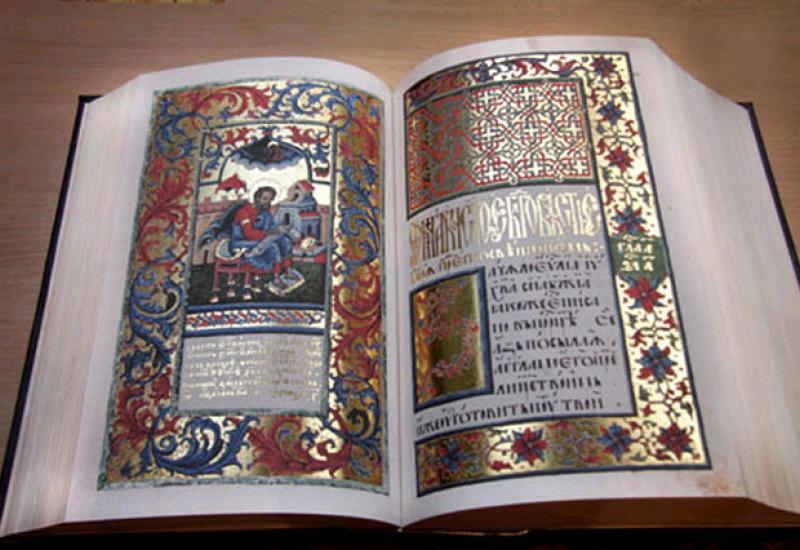What can tell an ancient manuscript? Most often, it has neither the author nor the name. Peresopnytsia Gospel - one of the few manuscripts, the history of creation of which is described in the manuscript.
Peresopnytsia Gospel was written in the years 1556-1561 in the monastery of princes Zaslavsky at Holy Trinity Church in Peresopnytsia monastery in Volhyn (now Rivne region).
From the text of the Gospel we learn that this great work was done by two monks: archpriest Mikhail Vasilyevich Sanotsky and Archimandrite of Peresopnytsia monastery Gregory. Translators have taken care the descendants will know about the founders of this work. The first left his name at the end of each Gospel: in the Gospels of Matthew and John, he described himself as "Michael Vasil'evich, archpriest Sanotsky" in the Gospel of Mark - "the great sinner slave Michael," and in the Gospel of Luke - "clerk Mikhail Vasilyevich of Sanok ". The second authored the work in these words: "those four books were arranged by Hieromonk Gregory Archimandrite Peresopnytsia."
It is unknown what kind of education they were received Gregory Peresopnytsia and Michael Sanotsky, but judging by the quality of translation and additions, it was high enough for the time. Gregory Peresopnytsia and Michael Sanotsky made their translation "for better understanding of Christianity."
Peresopnytsia Gospel manuscript is a book bound in oak boards covered with green velvet. It was written in ink on parchment beautiful letter. Registry, inserts and an epilogue made, as the authors put it, "small letters." The headings are written gold lettering. Pages in each of the four Gospels were marked in red ink so-called conceived to explain how to read texts in the church. The book consists of 63 notebooks and 960 pages.
Peresopnytsia Gospel is the first church book in Ukraine, translated from the Church-Slavonic on the old Ukrainian language: a "from language Bulgarian into Russian language". The beginning of this work was laid by the monks of Holy Trinity Monastery in the village Palaces (on Rivne) in 1556, and completed by the monks of the monastery Peresopnytsia (also in Rivne) in 1561
Peresopnytsia Gospel was not a single phenomenon, but reflected one of the East Slavic Orthodox stages of consciousness, as well as the formation of the Ukrainian language. Of course, this is not the Ukrainian language, which we know after Ivan Kotlyarevsky. It kept a lot of the old Russian, also noticeable influence of the Polish language and even Czech, words and expressions which are used in the Polish language in the XVI century. However, the translators added new features of colloquial speech of the XVI century, not only in vocabulary but also in phonetics and grammar.
Peresopnytsia Gospel was written during the search for Ukrainian own cultural, linguistic and religious identity.
Surprisingly, the gospel of Peresopnytsia was remembered and used for centuries. The cover of the manuscript was changed at least three times. On the pages there are marks made in different languages that belong to different epochs. On the first pages - the inscription in the Ukrainian language, made by I.Mazepa, on the transfer of the Gospel bishop Perejaslavsky. There is also an inscription in Latin, witnessing that the manuscript was in Pereyaslav seminary. already in the twentieth century. The Gospel was in Poltava library, then at the Museum of Kyiv-Pechersk Lavra.
It was assumed that during the Great Patriotic War the Gospel was destroyed. Manuscript was found again by the professor of Kyiv University S.I. Maslov in archive Kyiv-Pechersk Lavra in a small trunk. Somebody rescued a priceless treasure. At the initiative of Professor the book was handed to the National Library of Ukraine of V. Vernadsky.
During the inauguration of President of Ukraine in December 1991 Peresopnytsia Gospel was first used as a symbol of statehood. Leonid Kravchuk swore an oath of allegiance to Ukraine on it. Since that time, there was a tradition to swear on this book of the President of Ukraine.
In August, it will be celebrated 450 years Peresopnytsia Gospel, so 2011 has been declared the Year of Ukrainian Pervoknigi.
In the history of every nation there are few books which he keeps through the ages, and refers to a specific, iconic, symbolic, according to their own sacred relics. Peresopnytsia Gospel belongs to such books.

